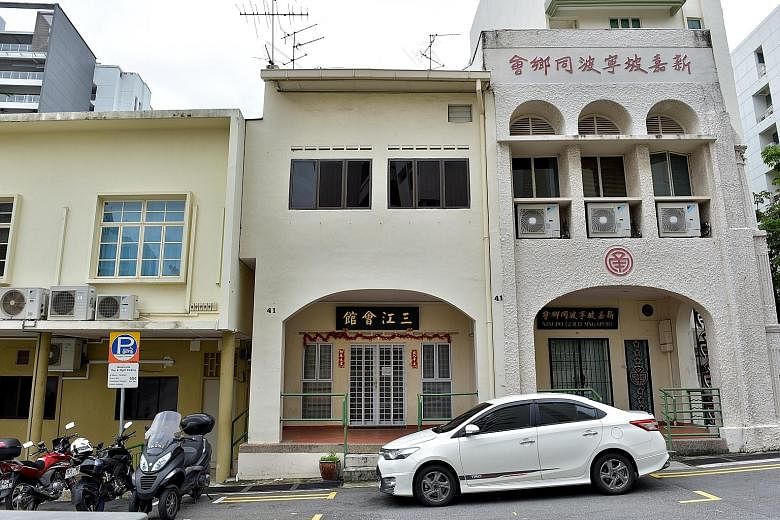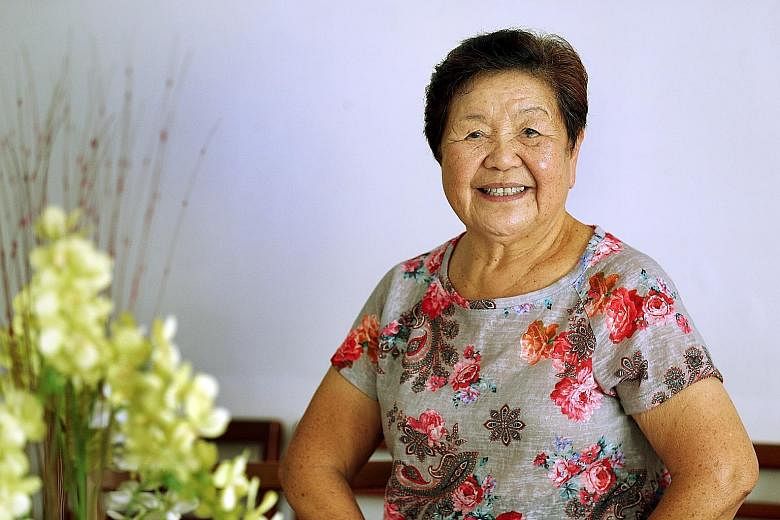The Shanghainese dialect classes at Sam Kiang Huay Kwan used to draw more than 100 students a year at its peak in the mid-2000s.
Choruses of "nong ho" (hello) and "zeh weh" (goodbye) rang out of the clan association's premises in Wilkie Road as business folk learnt the basics of the lingua franca of Shanghai, China's biggest city and financial hub.
But student numbers dwindled over the years, and the classes were stopped around 2013. It was only in the last year that the clan association had enough students to start a class again.
It is the same story at JSU Language School, one of the first to offer Shanghainese in 2003. In the past five years, the school has had four students, including a young man who wanted to pick up the dialect to communicate with his girlfriend in her tongue, said Ms Wang Yiyi, 30, a teacher there.
Mr Chen Jian, 50, who taught conversational Shanghainese at Sam Kiang, said his students were mostly Singaporeans with links to Shanghai and its 24 million people. But Mandarin, and to some extent English, are widely used in the city these days, and there is less impetus to learn the dialect, he said. Even in Shanghai, the use of the dialect has waned.
In Singapore, the label Shanghainese is used loosely and describes the various dialects of those who trace their roots to the three provinces of Zhejiang, Jiangsu and Jiangxi, collectively called Sanjiang.
This is due to a quirk in the registration of Sanjiang immigrants in the 1900s. Most of them left China via the port of Shanghai, and were typically mislabelled as Shanghainese by British Customs officers unfamiliar with the less-well- known parts of China.
In actual fact, there were few native Shanghainese among the early generation of immigrants here, National University of Singapore history graduate Shen Lingxie wrote in The Sanjiangren In Singapore, published in the academic journal Chinese Southern Diaspora Studies in 2012. Many "Shanghainese", including prominent ones like the Shaw brothers, Mr Runme Shaw and Mr Run Run Shaw, had in fact come from Ningbo city in Zhejiang.
As a result, there is often a smattering of the Ningbo dialect mixed into Shanghainese here. For instance, people often use the Ningbo "a la" (we) instead of the traditional Shanghainese "ngo".
The two dialects have differences in tone and sound systems. But those who speak one are often able to understand the other, said Mr Chen, who has roots in Ningbo.
While Shanghainese is constantly evolving in its hometown, the version spoken in Singapore has not changed much since it was brought over by immigrants in the 1900s.
Most of those born and bred here who picked up the dialect from their elders, speak old-style Shanghainese dating from the 1920s.
-
Speaking the dialect
-
ORIGINS
Shanghainese is a branch of the Wu family of dialects, and traces its roots to more than 2,000 years ago.
The dialect does not have a standard written form, and there are variations in how it is spoken even within Shanghai, China.
What is widely described as Shanghainese these days is the version spoken by people in the city of Shanghai.
NUMBER OF SPEAKERS
According to government figures from 2010, there are at least 22,000 people here belonging to the Shanghainese dialect group, the eighth-largest Chinese dialect group.But among this group, not many speak the dialect, especially among the younger generation.
The older generation of Shanghainese, many of whom are fluent in the dialect, have gradually decreased in number.
Nanyang Technological University School of Humanities and Social Sciences chair Liu Hong, who studies Chinese international migration, said it is hard to estimate how many people here actually speak Shanghainese because there are no precise statistics on the number of new immigrants from Shanghai.
WHERE TO LEARN
The Sam Kiang Huay Kwan (6333-9790) plans to start a class this year, and can arrange for lessons if there is enough interest.JSU Language School (6336-3055) offers one-on- one lessons.
They still refer to money as "dong di" (copper coins), and not "tso pio" (banknote), which is used by those who speak new-style Shanghainese that emerged around the 1970s.
Mrs Yang Siew Ling, 81, who often accompanies her husband to Shanghai on business trips, says there is also a difference in how Shanghainese and Singaporeans give praise. "We say 'meh ho' (very good), but they say 'loh ho'. When I first heard it in Shanghai, I couldn't understand what it meant."
Her husband, also of Shanghainese descent, runs a furniture business that has a factory in Shanghai. In the early days, Shanghainese Singaporeans were often associated with furniture, tailoring, piano and book businesses.
Retired librarian Khoo Sait Poh, 67, said the more modern version of Shanghainese is spoken in a much quicker pace, unlike the flowing version that rolls off the tongue of older speakers like her late parents.
As her husband and daughter do not speak the dialect, she does not get to use it much these days. "Occasionally, my sister and I will use it when we are out and when we don't want people to know what we are saying," she said.
Many younger generation Shanghainese Singaporeans no longer use the dialect, with dialects in general becoming less prevalent here.
Mrs Yang, who came to Singapore from Shanghai 70 years ago, feels it will be a pity for Shanghainese to disappear one day, and tries in her own way to prevent that from happening at home.
When her grandchildren were young, she would sometimes chide them using the Shanghainese phrase "ve yo ka wa" (don't be naughty), she said with a chuckle.
"Now I chat with them in Shanghainese when I can. I ask about their day and their lives, 'jing zo ho va' (was today a good day?), 'nong zo sa ma si' (what are you doing?). But they usually respond in English."
Of her seven grandchildren, two are more familiar with the dialect and do speak it sparingly.
Unlike Hokkien and Cantonese, which are used in daily communication and popularised by songs and films, Shanghainese is mainly used by those who have ties with the city itself, and so did not become widespread here, said Nanyang Technological University School of Humanities and Social Sciences chair Liu Hong, who studies Chinese international migration.
Mrs Yang remembers that even in her youth, not many outside of the Shanghainese community could understand the dialect. She quipped: "Shanghainese people speak rather loudly, and everyone could hear when we were talking on the bus. But because they didn't understand us, they would think we were having an argument."
Even at Sam Kiang Huay Kwan, started by early immigrants from Sanjiang, meetings are held in Mandarin. The association has expanded over the years to represent people from other parts of China, and using a particular dialect would not be feasible, said its assistant executive secretary, Mr Kevin Su.
Anecdotally, though, Shanghainese may be having a mini revival, thanks to new immigrants. These days, Madam Khoo occasionally hears snatches of it at the Bukit Timah supermarket she frequents.
Sam Kiang's Mr Su, 39, a Shanghai native who has called Singapore home since 2008, said when new immigrants get together, they naturally gravitate towards the dialect as it lends a sense of closeness.
But he has not made any special effort to teach his daughter, eight, and son, five, to speak it. "I'm not too concerned if they can't speak it. Languages are always changing, new ones emerge, old ones die off... I will let it take its course," he said.
But Madam Khoo is still wistful and misses the dialect with which she spoke daily to her parents. She travels to China a few times a year and relishes the chance to converse in Shanghainese. She also joins activities at Sam Kiang to meet others who speak the dialect.
"There are some things that just cannot be expressed in other dialects," said Madam Khoo, who also speaks English and Mandarin.
"Scolding people in Shanghainese is a lot more vivid. I remember when my mother used to scold us. But if I use it on my daughter, she won't understand."



